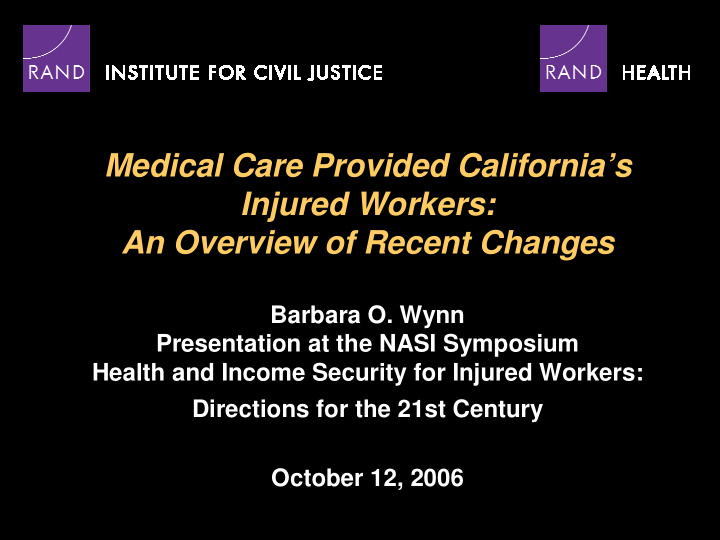



Medical Care Provided California’s Injured Workers: An Overview of Recent Changes Barbara O. Wynn Presentation at the NASI Symposium Health and Income Security for Injured Workers: Directions for the 21st Century October 12, 2006
Today’s Presentation • Describe the context for the medical reform provisions • Summarize the major reform provisions affecting medical care provided California’s injured workers • Suggest early “lessons-learned” from California’s experience 10/12/06
CA Workers’ Compensation Paid Losses : 2001-2005 Insurers’ Paid Losses (thousands) $5,000,000 $4,000,000 $3,000,000 $2,000,000 $1,000,000 2001 2002 2003 $0 2004 Medical Temporary Permanent Vocational Death 2005 Payments Disability Disability Rehabilitation Source: CHSWC 10/12/06
Medical Expenditures in CA Workers’ Comp (Paid by Insured Employers Only), 1997-2003 $6,000,000 Paid Amount (in Thousands) Physicians Hospital $5,000,000 Pharmacy All Other $4,000,000 $3,000,000 $2,000,000 $1,000,000 $0 1997 1998 1999 2000 2001 2002 2003 Calendar Year SOURCES: WCIRB /CHSWC 10/12/06
CA’s WC Costs Per $100 Payroll Rose Much Faster than the National Average over 1999-2003 Period % Change in Costs 60.0% Per $100 Wages 40.0% 20.0% 0.0% California United States -20.0% Medical Indemnity Total Source: NASI, 2005 10/12/06
Utilization Was Driving Medical Care Expenses 35 30 25 20 34.1 15 29.7 10 17.4 17 16.6 12.2 11.6 5 7.8 0 Average Visits per Median Physician Median Chiropractic Median Physical Claim Visits Visits Therapist Visits CA 12-State Median Source: Eccleston (Workers’ Compensation Research Institute), 2003 10/12/06
Despite More Care , CA’s Injured Workers Had Poorer Outcomes Percentage of PPD Claimants Out of Work after Three Years California 13.7% Wisconsin New Mexico Washington 11.8% Oregon 11.5% 11.2% 9.7% Data Source: RAND 10/12/06
Employers/Payers Had Limited Ability To Control Medical Expenses • Injured worker could select a primary treating physician after 30 days • Care provided by primary treating physician was presumptively correct • Utilization review physician opinions were not admitted as evidence in appeals • Official medical fee schedule inadequate 10/12/06
Recent Legislation Addressed Utilization and Cost Issues • Treating physician presumption repealed; ACOEM guidelines presumptively correct until AD issues a utilization schedule • UR guidelines repealed; new standards for UR processes • Employers may establish medical networks and control medical care for duration of claim • 24-visit limit per industrial injury on chiropractic, PT and OT • Second opinion program for spinal surgery • Up to $10,000 in payments before compensability established • Fee schedule expanded to include outpatient surgery facility fees and other services • Allowable fees for pharmaceuticals lowered and generic drugs required 10/12/06
Early Impressions from RAND Interviews and Studies Conducted by Other Researchers • Substantial reductions in utilization and medical costs • Unknown impact on access, clinical quality and on work-related outcomes and expenditures • Two systemic issues commonly raised by interviewees – The challenges posed by the complexity of four different medical delivery models with different utilization and dispute-resolution processes – The level of distrust and contention within the system Incentives for various stakeholders warrant analysis 10/12/06
What is Needed in CA WC to Drive Value-Based Medical Care for Injured Workers? • On-going monitoring system to assess system performance: access, quality, cost, utilization, and patient satisfaction • Clinical criteria to measure appropriate care • Readily accessible evidence-based treatment information on common workers’ compensation conditions and modalities • Implementation of new physician fee schedule and financial incentives to improve quality • Evaluation of reform initiatives to inform future policy development 10/12/06
What Are Early Lessons Learned for Other States? • On-going monitoring and evaluation system needed to produce information at critical junctures: – Technical assistance in legislative and regulatory processes – Early warning system during implementation – Monitoring and evaluation to inform future policy development • “Off-the shelf” policies still need to be adapted to local context – ACOEM guidelines are not comprehensive – Medicare-fee schedules do not address some occupational medicine services and some are not appropriate for WC population – Implementation of new physician fee schedule and financial incentives to improve quality • Successful implementation requires time and resources – Involvement of stakeholders in policy development – Educational materials for affected parties – “Ombudsman” to help communication and resolve problems • Regulatory authority for oversight and ability to address unintended consequences is important 10/12/06
Sources: California Commission on Health and Safety and Workers’ Compensation (CHSWC), Annual Reports, 1999-2005. Oakland, CA: CHSWC. Online at http://www.dir.ca.gov/chswc. Eccleston, S.M. and X. Zhao, “The Anatomy of Workers’ Compensation Medical Costs and Utilization: Trends and Interstate Comparisons, 1996-2000,” Cambridge, MA: Workers Compensation Research Institute, July 2003. Workers’ Compensation Insurance Rating Bureau (WCIRB), “2003 California Workers’ Compensation Insured Losses and Expenses,” San Francisco, CA: WCIRB, June 2004. Online at http://wcirbonline.org (as of December 21, 2004). National Academy of Social Insurance (NASI), Workers’Compensation: Benefits, Coverage, and Costs, 2003 . Washington, DC: NASI, July 2005. 10/12/06
Recommend
More recommend